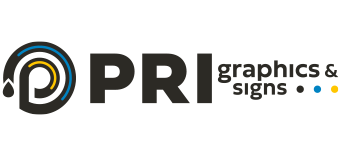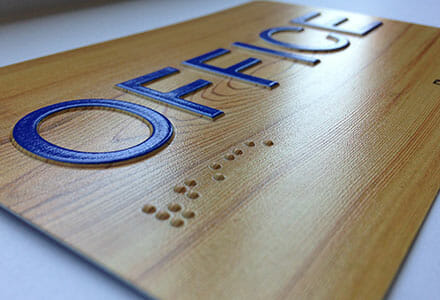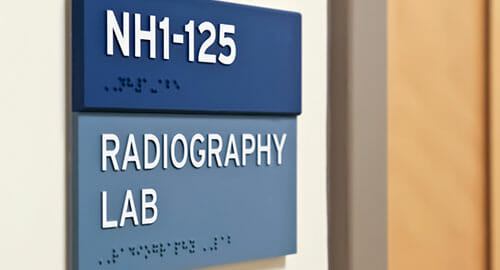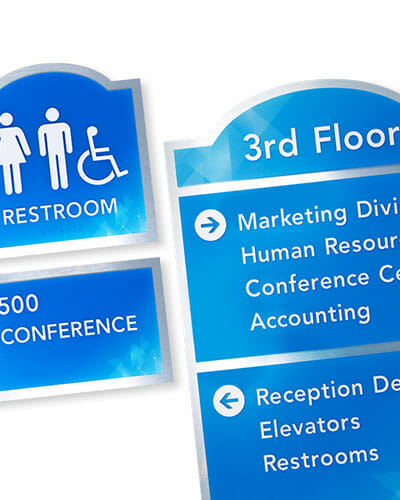Fast In-House Printing of Custom ADA Compliant Signs
Braille, Disability & General ADA Signage
Looking for expertly printed ADA signage that meets federal and local accessibility standards?
PRI Graphics in Phoenix specializes in fast ADA sign printing services for commercial and public spaces. Whether you need interior ADA signage, Braille bathroom signs, or wayfinding and directional signs, our team ensures full compliance with the Americans with Disabilities Act (ADA) and current building codes.
As your printer for ADA signs, RI Graphics & Signs has the specialized print and sign equipment to handle the job in-house. This allows us to print your ADA signs quickly (within 2-4 weeks) and at a reasonable cost.
We work directly with general contractors, construction teams, developers, and architects to ensure every project includes fully compliant signage—from entrances and exits to restrooms, parking, and elevator areas. If you’re designing or renovating a space, let us help manage your ADA printing requirements from start to finish.
Please call our print professionals at (602) 393-3131 or toll-free at (877) 409-8889 or email us.
Understanding ADA Signage Requirements
In the United States, the ADA has strict rules about ADA-accessible signage in public buildings. These standards apply across a range of public settings, including office buildings, government facilities, medical centers, and restaurants.
The objective of these standards is to ensure easy access, consistency, and a positive interactive experience for all persons with disabilities, regardless of what type of public building they visit.
Whether you’re outfitting a new building with wayfinding signage or upgrading existing signage, ADA regulations cover key elements such as:
- Tactile lettering and Grade 2 Braille
- High-contrast color schemes for visual accessibility
- Specific font styles (sans serif, uppercase only)
- Non-glare finishes and durable materials
- Exact mounting height and installation positioning
- Use of pictograms like the International Symbol of Accessibility
At PRI Graphics, we specialize in printing all types of signage and understand the ADA requirements. We can ensure that your ADA printing will be completely compliant. Call lus toll-free at (877) 409-8889 to request a quote.
Additional ADA Signage Services:
We also print ADA compliant signage for:
- Accessible parking & van-accessible areas
- Restroom & gender-neutral bathrooms
- Elevator & stairwell identification
- Emergency exit and evacuation signage
- Construction ADA signage requirements
Let PRI Graphics help streamline the signage portion of your build, remodel, or inspection preparation. We support your compliance and branding needs in one place.
Why Choose PRI Graphics for ADA Sign Printing?
PRI Graphics offers in-house production of custom tactile signage using advanced print equipment for fast turnarounds and precise quality control. With experience serving everything from hospitals and schools to retail centers and restaurants, we tailor solutions to your project type and branding while ensuring strict ADA compliance.
Need ADA-compliant directional signs, wayfinding maps, or tactile exit signage? Call our experienced team today at (602) 393-3131 or toll-free at (877) 409-8889.
ADA Signage FAQ
Voice search queries have become increasingly popular as people use voice-activated assistants (like Siri, Alexa, or Google Assistant) to find information quickly.
Below, PRI Graphics & Signs has provided some of the most common voice search FAQs related to ADA signage, which are tailored for users looking for quick, conversational answers. This updated list reflects current trends and questions being asked about ADA signage, including changes in digital signage and new standards for universal design.
What is ADA signage?
ADA signage refers to signs that comply with the Americans with Disabilities Act (ADA) regulations. The regulations ensure that individuals with disabilities have access to and are able to navigate public spaces. These signs are designed to be easily understood by people with various disabilities, including visual impairments and mobility challenges.
When was the ADA signed into law?
The Americans with Disabilities Act (ADA) was signed into law on July 26, 1990, by President George H. W. Bush. It prohibits discrimination based on disability and mandates accessibility requirements in public spaces, including signage.
Where are ADA signs required?
ADA signs are required in all public and commercial spaces that are open to the public, including Restrooms, Elevators, Accessible Parking Spaces, Room identification (offices, conference rooms, etc.), Directional signage (to help people navigate buildings), and Exit Signs and emergency routes.
What makes a sign ADA compliant?
ADA compliance for signage requires several key features including:
• Readable Text - Clear, high-contrast text that is easy to read.
• Braille - Braille for individuals with visual impairments.
• Non-Glare Surfaces - No reflective or glossy finishes.
• Accessible Placement - Signs must be positioned typically between 48 and 60 inches above the floor.
• Pictograms or Symbols - Easily recognizable symbols that convey the message visually, in addition to text.
What is the ADA height for signage?
The standard height for ADA-compliant signage is between 48 and 60 inches above the floor for wall-mounted signs. Signs with Braille should be placed with the centerline of the sign between 60 and 62 inches above the ground, depending on the application.
What does ADA stand for in signs?
ADA stands for the Americans with Disabilities Act, a law that sets the standards for accessibility in public spaces, including signage.
How do you make an ADA sign?
To make an ADA-compliant sign, the following steps should be followed:
• Use High-Contrast Text (e.g., black text on a white or light-colored background).
• Include Braille where necessary (Grade 2 Braille is the standard).
• Use clear, easy-to-understand pictograms or symbols.
• Ensure the size and placement comply with ADA standards (e.g., appropriate height and spacing).
• Use non-glare, matte materials for readability.
• If required, include tactile characters (raised text) that are easy to feel by touch.
What are the new updates to ADA signage guidelines?
1. Recent ADA updates emphasize the need for clearer emergency signage, such as exit signs with high contrast and improved tactile features.
2. The use of touch-activated signage (such as digital kiosks) must still comply with ADA standards for accessibility, including audio and tactile feedback.
3. Enhanced standards for universal design, such as additional color contrast for people with color blindness or low vision, have become a focus in new guidelines.
4. There is a growing emphasis on ensuring that digital signage (such as screens and monitors) is accessible, with features like adjustable font sizes, audio descriptions, and Braille.
Are there exceptions to ADA signage requirements?
Yes, exceptions exist under specific circumstances. For example, signage in private areas not open to the public or areas with no accessible route may not require ADA compliance. Additionally, there are specific exemptions related to small buildings or spaces with limited occupancy, but these situations are rare and typically determined by local building codes.
Can ADA signs be digital or electronic?
Yes, digital, and electronic signs can be ADA compliant, but they must still adhere to guidelines for visibility, readability, and accessibility. For example, they should include accessible features like high-contrast text, the ability to adjust font size, audio descriptions for visual content, and tactile feedback when necessary.
Get fast turnarounds (2-4 weeks) with our experienced printing team today.
Call us at (602) 393-3131 or toll-free at (877) 409-8889.







